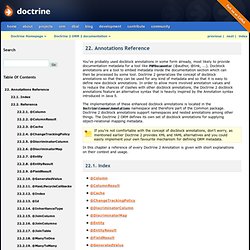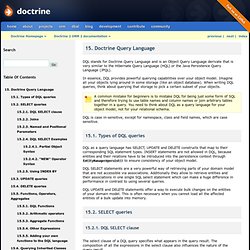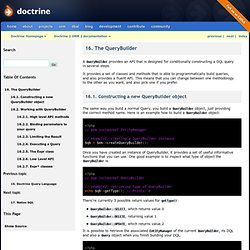

Doctrine : Annotations Reference. You’ve probably used docblock annotations in some form already, most likely to provide documentation metadata for a tool like PHPDocumentor (@author, @link, ...).

Docblock annotations are a tool to embed metadata inside the documentation section which can then be processed by some tool. Doctrine 2 generalizes the concept of docblock annotations so that they can be used for any kind of metadata and so that it is easy to define new docblock annotations. In order to allow more involved annotation values and to reduce the chances of clashes with other docblock annotations, the Doctrine 2 docblock annotations feature an alternative syntax that is heavily inspired by the Annotation syntax introduced in Java 5. The implementation of these enhanced docblock annotations is located in the Doctrine\Common\Annotations namespace and therefore part of the Common package. Doctrine 2 docblock annotations support namespaces and nested annotations among other things. 22.2.1.
Required attributes: Note <? <? Symfony, High Performance PHP Framework for Web Development. Accueil - Blog - Tutoriel-Symfony2. Welcome to Doctrine 2 ORM’s documentation! — Doctrine 2 ORM 2 documentation. The Doctrine documentation is comprised of tutorials, a reference section and cookbook articles that explain different parts of the Object Relational mapper.

Doctrine DBAL and Doctrine Common both have their own documentation. Getting Help If this documentation is not helping to answer questions you have about Doctrine ORM don’t panic. You can get help from different sources: Symfony2 checklist de déploiement. Accueil - Blog - Tutoriel-Symfony2. 15. Doctrine Query Language — Doctrine 2 ORM 2 documentation. 15.2.1.

DQL SELECT clause The select clause of a DQL query specifies what appears in the query result. The composition of all the expressions in the select clause also influences the nature of the query result. Here is an example that selects all users with an age > 20: <? Lets examine the query: u is a so called identification variable or alias that refers to the MyProject\Model\User class. The result of this query would be a list of User objects where all users are older than 20. The SELECT clause allows to specify both class identification variables that signal the hydration of a complete entity class or just fields of the entity using the syntax u.name. 15.2.2. A SELECT query can contain joins. Regular Joins: Used to limit the results and/or compute aggregate values. Fetch Joins: In addition to the uses of regular joins: Used to fetch related entities and include them in the hydrated result of a query. There is no special DQL keyword that distinguishes a regular join from a fetch join.
<? 16. The QueryBuilder — Doctrine 2 ORM 2 documentation. A QueryBuilder provides an API that is designed for conditionally constructing a DQL query in several steps.

It provides a set of classes and methods that is able to programmatically build queries, and also provides a fluent API. This means that you can change between one methodology to the other as you want, and also pick one if you prefer. 16.1. Constructing a new QueryBuilder object The same way you build a normal Query, you build a QueryBuilder object, just providing the correct method name. <? Once you have created an instance of QueryBuilder, it provides a set of useful informative functions that you can use. <? There’re currently 3 possible return values for getType(): QueryBuilder::SELECT, which returns value 0QueryBuilder::DELETE, returning value 1QueryBuilder::UPDATE, which returns value 2 It is possible to retrieve the associated EntityManager of the current QueryBuilder, its DQL and also a Query object when you finish building your DQL.
<? Welcome to Doctrine 2 ORM’s documentation! — Doctrine 2 ORM 2 documentation. Documentation - Twig - The flexible, fast, and secure PHP template engine.